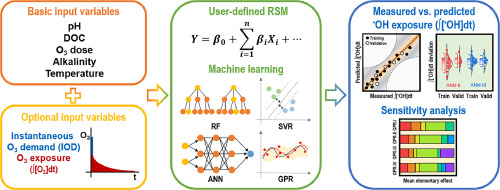Publication
Advanced Redox Technology Lab
Publication
Advanced Redox Technology Lab
Journal papers
The abatement of micropollutants by ozonation can be accurately calculated by measuring the exposures of molecular ozone (O3) and hydroxyl radical (•OH) (i.e., ∫[O3]dt and ∫[•OH]dt). In the actual ozonation process, ∫[O3]dt values can be calculated by monitoring the O3 decay during the process. However, calculating ∫[•OH]dt is challenging in the field, which necessitates developing models to predict ∫[•OH]dt from measurable parameters. This study demonstrates the development of machine learning models to predict ∫[•OH]dt (the output variable) from five basic input variables (pH, dissolved organic carbon concentration, alkalinity, temperature, and O3 dose) and two optional ones (∫[O3]dt and instantaneous ozone demand, IOD). To develop the models, four different machine learning methods (random forest, support vector regression, artificial neural network, and Gaussian process regression) were employed using the input and output variables measured (or determined) in 130 different natural water samples. The results indicated that incorporating ∫[O3]dt as an input variable significantly improved the accuracy of prediction models, increasing overall R2 by 0.01−0.09, depending on the machine learning method. This suggests that ∫[O3]dt plays a crucial role as a key variable reflecting the •OH-yielding characteristics of dissolved organic matter. Conversely, IOD had a minimal impact on the accuracy of the prediction models. Generally, machine-learning-based prediction models outperformed those based on the response surface methodology developed as a control. Notably, models utilizing the Gaussian process regression algorithm demonstrated the highest coefficients of determination (overall R2 = 0.91−0.95) among the prediction models.
